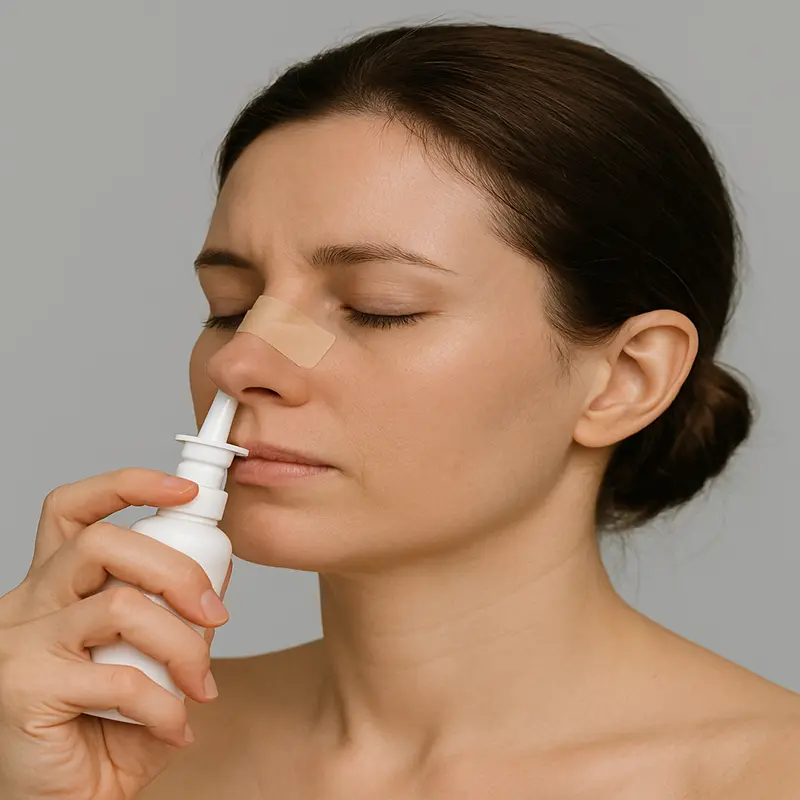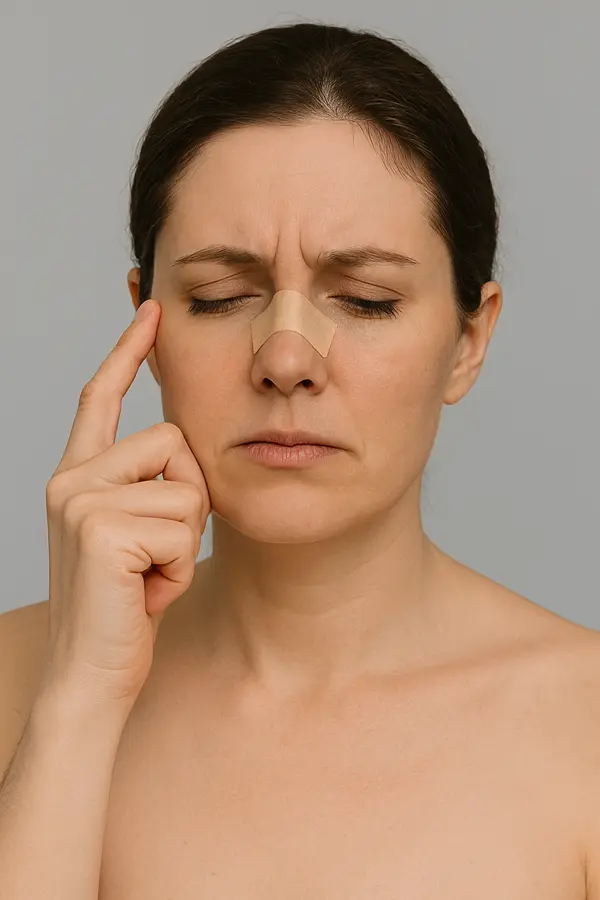"Are rhinoplasty painful?" and "Are rhinoplasty dangerous?" If you're considering rhinoplasty, you've probably asked yourself two crucial questions:
If you're considering rhinoplasty, you've probably asked yourself two crucial questions: "Are rhinoplasty painful?" and "Are rhinoplasty dangerous?" These concerns are completely natural, and understanding the facts about pain management and safety can help you make an informed decision about your nose surgery.
This comprehensive guide addresses both the discomfort levels you can expect and the safety measures that make modern rhinoplasty one of the most successful cosmetic procedures available today.
The good news is that rhinoplasty itself is not painful during the procedure. Modern anesthesia techniques ensure you remain completely comfortable throughout your surgery. Most rhinoplasty procedures use general anesthesia, which means you’ll be asleep and feel nothing during the operation.
Some surgeons may opt for local anesthesia with sedation for minor revisions, but even in these cases, you won’t experience pain during the actual procedure.
When people ask “are rhinoplasty painful,” they’re usually concerned about the recovery period. Here’s what you can realistically expect:
Days 1-3: This is typically when discomfort is at its peak. Most patients describe the sensation as similar to a severe sinus infection rather than sharp, stabbing pain. You’ll likely experience:
● Nasal congestion and stuffiness
● Pressure around the nose and eyes
● Mild to moderate aching
● Some difficulty breathing through your nose
Days 4-7: Pain levels generally decrease significantly during this period. Many patients find that over-the-counter pain medications are sufficient to manage any remaining discomfort.
Week 2 and beyond: Most patients report minimal to no pain by this point, though some tenderness when touching the nose area may persist for several weeks.


Modern pain management makes rhinoplasty recovery much more comfortable than in the past:
Prescribed medications: Your surgeon will provide appropriate pain relief medications for the first few days when discomfort is typically highest.
Cold therapy: Ice packs applied around (not directly on) the surgical area can significantly reduce swelling and discomfort.
Elevation: Keeping your head elevated while sleeping helps minimize swelling and associated pressure.
Proper rest: Adequate sleep and avoiding strenuous activities allow your body to heal more efficiently with less discomfort.
When performed by qualified, experienced surgeons, rhinoplasty has an excellent safety record. Serious complications are rare, occurring in less than 1% of cases when proper protocols are followed.
The question “are rhinoplasty dangerous” often stems from misconceptions about cosmetic surgery risks. Like any surgical procedure, rhinoplasty does carry some risks, but these are generally minor and manageable when you choose the right surgeon and facility.
Bleeding: Minor bleeding is normal for the first 24-48 hours. Serious bleeding complications are rare and can be prevented through proper pre-surgical screening and post-operative care.
Infection: Post-surgical infections occur in less than 2% of rhinoplasty cases. Prophylactic antibiotics and proper wound care significantly reduce this risk.
Adverse reaction to anesthesia: Modern anesthesia monitoring and qualified anesthesiologists make serious complications extremely rare.
Scarring: External scars from open rhinoplasty are typically minimal and fade significantly over time. Internal scarring can occasionally affect breathing but is uncommon with proper technique.

Surgeon qualifications: Board-certified plastic surgeons or facial plastic surgeons have extensive training specifically in nasal anatomy and surgical techniques.
Accredited facilities: Surgery performed in accredited surgical facilities with proper equipment and emergency protocols significantly enhances safety.
Comprehensive pre-operative evaluation: Thorough health screening identifies potential risk factors before surgery.
Realistic expectations: Clear communication between patient and surgeon about goals and limitations prevents revision surgeries.
Modern rhinoplasty techniques have evolved significantly, making procedures both safer and more predictable:
Preservation rhinoplasty: This newer technique maintains more of the nose’s natural structure, reducing trauma and healing time.
Ultrasonic technology: Precise bone sculpting with ultrasonic tools minimizes tissue damage and reduces recovery time.
3D imaging: Pre-surgical planning with advanced imaging helps surgeons achieve better results with fewer revisions.
Today’s anesthesia protocols are far more sophisticated than in the past. Continuous monitoring of vital signs, advanced airway management, and personalized anesthesia plans make the procedure remarkably safe.
Modern recovery protocols focus on:
● Minimizing swelling through specialized techniques
● Reducing infection risks with improved wound care
● Managing discomfort with targeted pain relief strategies
● Providing clear, detailed recovery instructions
While this is when you might wonder if rhinoplasty is painful, remember that discomfort peaks early and improves quickly. You’ll have nasal packing removed within a few days, and external splints typically come off after one week.
Swelling continues to decrease, and you’ll start to see your new nose shape emerging. Any remaining discomfort is usually mild and manageable with over-the-counter medications.
The healing process continues for months, with final results visible around the one-year mark. During this time, you should experience no significant discomfort.
Board certification: Ensure your surgeon is certified by the relevant plastic surgery or facial plastic surgery board.
Rhinoplasty specialization: Look for surgeons who perform nose surgery regularly and can show extensive before-and-after galleries.
Hospital privileges: Surgeons with hospital operating privileges have undergone additional credentialing processes.
● How many rhinoplasty procedures do you perform annually?
● What is your complication rate?
● Can you show me before-and-after photos of similar cases?
● What pain management protocols do you use?
● How do you handle complications if they arise?
Rhinoplasty is generally considered less painful than many other surgical procedures. Most patients rate their discomfort as moderate during the first few days, similar to a bad sinus infection. The pain is very manageable with prescribed medications and typically subsides quickly.
Serious complications are rare but can include severe bleeding, infection, adverse reactions to anesthesia, or significant breathing problems. These occur in less than 1% of cases when surgery is performed by qualified surgeons in accredited facilities.
Most patients experience their peak discomfort during the first 2-3 days after surgery. Pain typically becomes mild to moderate by day 4-5 and is usually minimal by the end of the first week. Some tenderness may persist for several weeks, but this shouldn't interfere with daily activities.
Your surgeon will prescribe appropriate pain medications for your specific needs. These may include prescription pain relievers for the first few days, after which most patients transition to over-the-counter medications like acetaminophen or ibuprofen (if approved by your surgeon).
Rhinoplasty becomes riskier when performed by unqualified surgeons, in non-accredited facilities, or without proper pre-operative evaluation. Choosing a board-certified surgeon and following all pre- and post-operative instructions significantly minimizes risks.
Normal recovery includes moderate swelling, some bruising around the eyes, nasal congestion, and mild to moderate discomfort for the first week. Contact your surgeon immediately if you experience severe pain, excessive bleeding, signs of infection, or severe breathing difficulties.
Understanding that rhinoplasty, while not entirely pain-free, is manageable and that modern techniques have made it very safe can help you make an informed decision about your surgery. The key lies in choosing an experienced, qualified surgeon and following proper pre- and post-operative care protocols.
Remember that every patient’s experience is unique. Some individuals may experience less discomfort than others, while some may need slightly longer to heal completely. Your surgeon will provide personalized information based on your specific case and medical history.
So, are rhinoplasty painful and dangerous? The honest answer is that rhinoplasty involves some discomfort during recovery, but this pain is typically manageable and temporary. As for safety, modern rhinoplasty performed by qualified surgeons has an excellent safety record with very low complication rates.
The key to a positive rhinoplasty experience lies in realistic expectations, choosing the right surgeon, and following proper recovery protocols. While no surgery is completely without risk or discomfort, rhinoplasty has helped millions of people achieve their aesthetic and functional goals safely and with minimal long-term issues.
If you’re considering rhinoplasty, focus on finding a qualified, experienced surgeon who can address your specific concerns and provide detailed information about what to expect during your recovery. With proper planning and care, your rhinoplasty experience can be both safe and successful, with manageable discomfort that quickly gives way to satisfaction with your results.
Take the time to research thoroughly, ask plenty of questions, and make sure you feel completely comfortable with your surgical team before proceeding. Your peace of mind and safety should always be the top priorities in your rhinoplasty journey.
Areas of Expertise

"Rhinoplasty offers an aesthetic and functional appearance by providing facial harmony."
"Rhinoplasty offers an aesthetic and functional appearance by providing facial harmony."
Detailed Info"Sinusitis is a painful condition caused by inflammation of the sinuses around the nose."
"Sinusitis is a painful condition caused by inflammation of the sinuses around the nose."
Detailed Info"Tonsil diseases are conditions that cause infection and swelling in the throat."
"Tonsil diseases are conditions that cause infection and swelling in the throat."
Detailed Info"Adenoids in children are enlarged lymphoid tissue that can cause nasal congestion."
"Adenoids in children are enlarged lymphoid tissue that can cause nasal congestion."
Detailed Info"Botulinum Toxin provides a youthful and smooth appearance on the face by reducing wrinkles."
"Botulinum Toxin provides a youthful and smooth appearance on the face by reducing wrinkles."
Detailed Info"In children, otitis media can cause earache and hearing problems."
"Facial rejuvenation with non-surgical methods reduces wrinkles and revitalizes the skin."
"Facial rejuvenation with non-surgical methods reduces wrinkles and revitalizes the skin."
Detailed Info"Sleep apnea is a disorder that causes breathing pauses during sleep."
At Dr. Osman Halit Çam’s clinic, we offer internationally recognized, patient-centered care with cutting-edge techniques in modern rhinoplasty and facial aesthetics.
From consultation to recovery, our mission is to provide personalized treatment in a safe, comfortable, and world-class medical environment.
Health innovations, treatment processes, and the latest news about our clinic are shared here.
A Comprehensive Guide to Rhinoplasty Correction Nose Job for Crooked Nose Nose job for crooked nose correction, understanding the procedure, benefits, and what to expect can help you make an informed decision about this transformative treatment. Get Info Nose job for crooked nose A crooked nose can significantly impact both your appearance and quality of […]
Your Complete Guide to Rhinoplasty and Piercings Can I Get a Nose Job with Nose Piercing Can I get nose job with nose piercing? This is one of the most common questions patients ask when planning their cosmetic surgery journey. Get Info Can I Get a Nose Job with Nose Piercing? If you’re considering rhinoplasty […]
What Older Adults Need to Know About Nose Surgery Rhinoplasty When You Get Old Rhinoplasty when you get old presents unique considerations that differ significantly from procedures performed on younger patients. Get Info What Older Adults Need to Know About Nose Surgery Rhinoplasty when you get old presents unique considerations that differ significantly from procedures […]
Each of the contents on this site has been prepared for informational purposes. Do not apply any of the treatment methods described on the site without the supervision of a doctor. Otherwise, the site management and Assoc. Prof. will not be responsible in any way for any problems that may arise. Dr. Osman Halit Çam is not responsible.
© 2023 – All Rights Reserved. Assoc. Dr. Osman Halit Cam
Last Updated: 25.07.2025